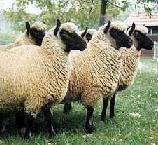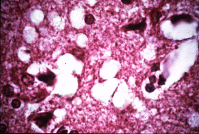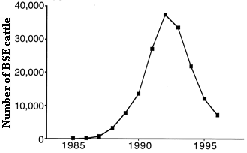III. THE DISCOVERY OF PRIONS
Scrapie, Kuru and CJD
 Prion diseases are nothing new to the world of science. The first disease showing the prion symptoms was scrapie. Shepherds throughout Europe had been familiar with the symptoms of scrapie for over 200 years.(Prusiner Prions 50) One strange symptom of this disease is dementia in sheep. Occasionally, they would begin scratching themselves against posts or trees and wouldn't stop until their wool and often their skin and muscle had completely rubbed away; hence the name "scrapie." The disease was rare and never a problem to humans, but no cause for the disease was ever found.
Prion diseases are nothing new to the world of science. The first disease showing the prion symptoms was scrapie. Shepherds throughout Europe had been familiar with the symptoms of scrapie for over 200 years.(Prusiner Prions 50) One strange symptom of this disease is dementia in sheep. Occasionally, they would begin scratching themselves against posts or trees and wouldn't stop until their wool and often their skin and muscle had completely rubbed away; hence the name "scrapie." The disease was rare and never a problem to humans, but no cause for the disease was ever found.
 Kuru was discovered in the tribes of Papua, New Guinea, where it remained isolated. None of those who traveled among the infected persons became infected, but the disease kept spreading among the natives. Eventually, the scientists Vincent Zigas and D. Carleton Gajdusek discovered that the tribes paid homage to their dead by eating their brains. Ever since the practice was discovered and stopped, new kuru cases have significantly declined.(Prusiner Prions 50) Because of his work with kuru, D. Carleton Gajdusek won the Nobel Prize in 1976. (Vogel 214)
Kuru was discovered in the tribes of Papua, New Guinea, where it remained isolated. None of those who traveled among the infected persons became infected, but the disease kept spreading among the natives. Eventually, the scientists Vincent Zigas and D. Carleton Gajdusek discovered that the tribes paid homage to their dead by eating their brains. Ever since the practice was discovered and stopped, new kuru cases have significantly declined.(Prusiner Prions 50) Because of his work with kuru, D. Carleton Gajdusek won the Nobel Prize in 1976. (Vogel 214)
Other diseases with similar characteristics have emerged. There is CJD and Gertsman-Sträussler-Scheinker syndrome (GSS) in humans, Bovine Spongiform Encephalopathy (BSE) in cows and several other diseases in various mammals. All prion diseases have several characteristics in common. They tend to have long incubation periods, they damage the brain, they fail to produce any immune response(CDC Creutzfeldt-Jakob 1) and above all, they are all progressive and deadly.(MAFF 1)
Prusiner's Research
 While Prusiner was pondering the causes of CJD, he noted the similarities between CJD and scrapie. Both diseases fit into the category of transmissible spongiform encephalopathies, or TSEs.(Prusiner Prion 48) These diseases have the characteristic pattern of leaving the brain riddled with holes and with a spongy appearance. His research led him to the names of Tikvah Alper and J. S. Griffith. Ms. Alper studied scrapie and discovered that it could still be transmitted after the tissue was exposed to radiation. Separately, Griffith suggested that proteins could mis-fold and cause other proteins to do the same.(Vogel 214)
While Prusiner was pondering the causes of CJD, he noted the similarities between CJD and scrapie. Both diseases fit into the category of transmissible spongiform encephalopathies, or TSEs.(Prusiner Prion 48) These diseases have the characteristic pattern of leaving the brain riddled with holes and with a spongy appearance. His research led him to the names of Tikvah Alper and J. S. Griffith. Ms. Alper studied scrapie and discovered that it could still be transmitted after the tissue was exposed to radiation. Separately, Griffith suggested that proteins could mis-fold and cause other proteins to do the same.(Vogel 214)
It was just a matter of time before Prusiner put the pieces together. He made the suggestion that scrapie and other TSEs are not caused by conventional methods of infection like bacteria and viruses, but by proteins. The news was revolutionary and controversial. Science hadn't considered a non-genetic infective agent plausible. Prusiner fought against public opinion for years before receiving recognition.(Ferry 33) Unfortunately, his recognition came as a wide-scale prion crisis was on the horizon.
Mad Cow Crisis
 The Biotechnology and Biological Research Council (BBSRC) keeps close track of many diseases around the British Isles. They noticed that the cattle seemed to be contracting a deadly disease. In November 1986, the scientists discovered a disease similar to scrapie in sheep. They called the disease Bovine Spongiform Encephalopathy (BSE). It reached epidemic proportions in Britain. It is now theorized that the BSE was contracted by feeding infected sheep protein to cows. This was later amplified by feeding infected cow proteins to cows.(CDC Report 1) Although the infected cattle were monitored and destroyed, the problem was not over.
The Biotechnology and Biological Research Council (BBSRC) keeps close track of many diseases around the British Isles. They noticed that the cattle seemed to be contracting a deadly disease. In November 1986, the scientists discovered a disease similar to scrapie in sheep. They called the disease Bovine Spongiform Encephalopathy (BSE). It reached epidemic proportions in Britain. It is now theorized that the BSE was contracted by feeding infected sheep protein to cows. This was later amplified by feeding infected cow proteins to cows.(CDC Report 1) Although the infected cattle were monitored and destroyed, the problem was not over.
New cases of CJD started appearing across Great Britain. At first, there didn't appear to be a problem, but these CJD cases were unusual. The scientists called the new strain vCJD [now nvCJD - 2001], for variant CJD. The patterns in the brain changed, but what was surprising was the new group infected.
"CJD afflicts one in a million people each year. Its incubation period is normally decades, so almost everyone affected is elderly: the average age of victims is around 63. The ten young victims [of vCJD], aged from 18 to 41, have an average age of 27 years.(Pain 6)
The World Health Organization carefully noted similarities between BSE and the new CJD cases which arose in Great Britain.(World Health Organization 1) Although it hasn't entirely been proven, it appears that the vCJD is a transformed strain of BSE which has passed to humans.(CDC Report 1) It will be interesting to see whether more vCJD cases emerge. Although meat restrictions are in place in Britain, there is a long "incubation" time characteristic of prion diseases. We may yet see cases of vCJD appear in the human population.


Return to the prion page or
go back to the overview.
 Prion diseases are nothing new to the world of science. The first disease showing the prion symptoms was scrapie. Shepherds throughout Europe had been familiar with the symptoms of scrapie for over 200 years.(Prusiner Prions 50) One strange symptom of this disease is dementia in sheep. Occasionally, they would begin scratching themselves against posts or trees and wouldn't stop until their wool and often their skin and muscle had completely rubbed away; hence the name "scrapie." The disease was rare and never a problem to humans, but no cause for the disease was ever found.
Prion diseases are nothing new to the world of science. The first disease showing the prion symptoms was scrapie. Shepherds throughout Europe had been familiar with the symptoms of scrapie for over 200 years.(Prusiner Prions 50) One strange symptom of this disease is dementia in sheep. Occasionally, they would begin scratching themselves against posts or trees and wouldn't stop until their wool and often their skin and muscle had completely rubbed away; hence the name "scrapie." The disease was rare and never a problem to humans, but no cause for the disease was ever found. Kuru was discovered in the tribes of Papua, New Guinea, where it remained isolated. None of those who traveled among the infected persons became infected, but the disease kept spreading among the natives. Eventually, the scientists Vincent Zigas and D. Carleton Gajdusek discovered that the tribes paid homage to their dead by eating their brains. Ever since the practice was discovered and stopped, new kuru cases have significantly declined.(Prusiner Prions 50) Because of his work with kuru, D. Carleton Gajdusek won the Nobel Prize in 1976. (Vogel 214)
Kuru was discovered in the tribes of Papua, New Guinea, where it remained isolated. None of those who traveled among the infected persons became infected, but the disease kept spreading among the natives. Eventually, the scientists Vincent Zigas and D. Carleton Gajdusek discovered that the tribes paid homage to their dead by eating their brains. Ever since the practice was discovered and stopped, new kuru cases have significantly declined.(Prusiner Prions 50) Because of his work with kuru, D. Carleton Gajdusek won the Nobel Prize in 1976. (Vogel 214) While Prusiner was pondering the causes of CJD, he noted the similarities between CJD and scrapie. Both diseases fit into the category of transmissible spongiform encephalopathies, or TSEs.(Prusiner Prion 48) These diseases have the characteristic pattern of leaving the brain riddled with holes and with a spongy appearance. His research led him to the names of Tikvah Alper and J. S. Griffith. Ms. Alper studied scrapie and discovered that it could still be transmitted after the tissue was exposed to radiation. Separately, Griffith suggested that proteins could mis-fold and cause other proteins to do the same.(Vogel 214)
While Prusiner was pondering the causes of CJD, he noted the similarities between CJD and scrapie. Both diseases fit into the category of transmissible spongiform encephalopathies, or TSEs.(Prusiner Prion 48) These diseases have the characteristic pattern of leaving the brain riddled with holes and with a spongy appearance. His research led him to the names of Tikvah Alper and J. S. Griffith. Ms. Alper studied scrapie and discovered that it could still be transmitted after the tissue was exposed to radiation. Separately, Griffith suggested that proteins could mis-fold and cause other proteins to do the same.(Vogel 214) The Biotechnology and Biological Research Council (BBSRC) keeps close track of many diseases around the British Isles. They noticed that the cattle seemed to be contracting a deadly disease. In November 1986, the scientists discovered a disease similar to scrapie in sheep. They called the disease Bovine Spongiform Encephalopathy (BSE). It reached epidemic proportions in Britain. It is now theorized that the BSE was contracted by feeding infected sheep protein to cows. This was later amplified by feeding infected cow proteins to cows.(CDC Report 1) Although the infected cattle were monitored and destroyed, the problem was not over.
The Biotechnology and Biological Research Council (BBSRC) keeps close track of many diseases around the British Isles. They noticed that the cattle seemed to be contracting a deadly disease. In November 1986, the scientists discovered a disease similar to scrapie in sheep. They called the disease Bovine Spongiform Encephalopathy (BSE). It reached epidemic proportions in Britain. It is now theorized that the BSE was contracted by feeding infected sheep protein to cows. This was later amplified by feeding infected cow proteins to cows.(CDC Report 1) Although the infected cattle were monitored and destroyed, the problem was not over.
